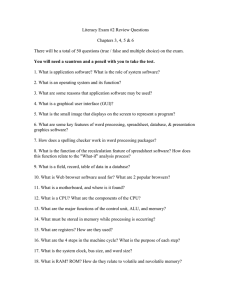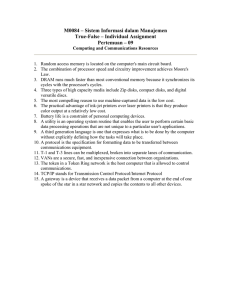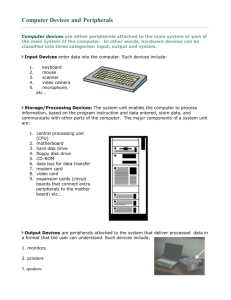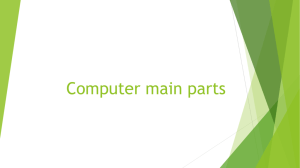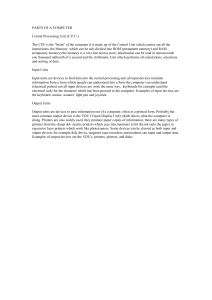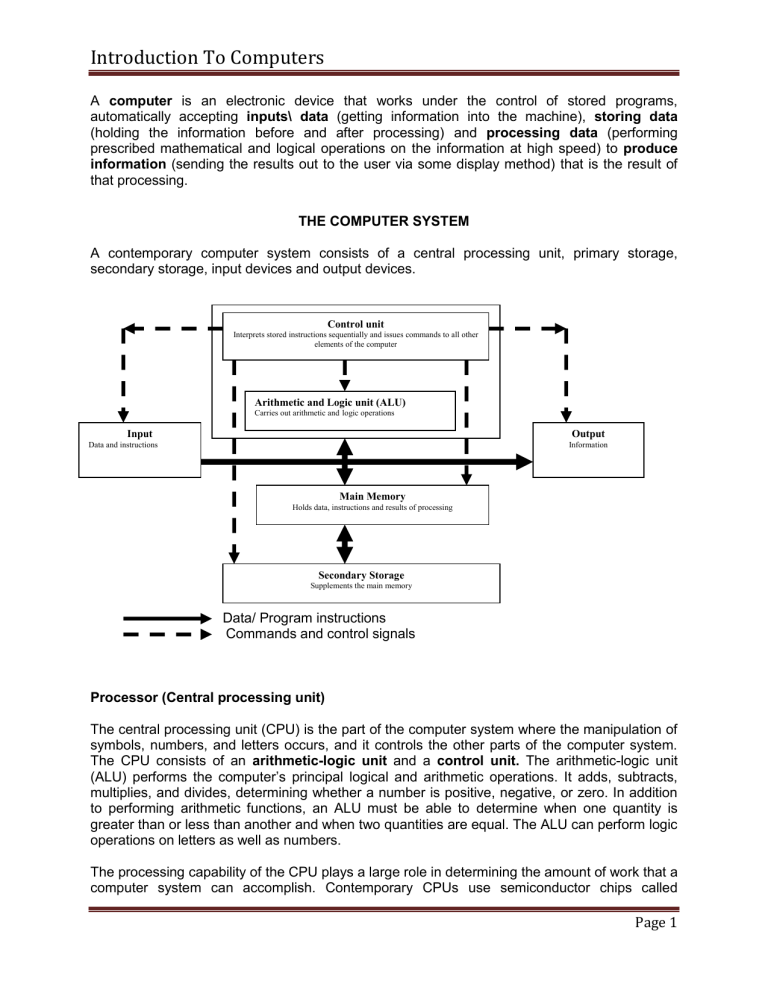
Introduction To Computers A computer is an electronic device that works under the control of stored programs, automatically accepting inputs\ data (getting information into the machine), storing data (holding the information before and after processing) and processing data (performing prescribed mathematical and logical operations on the information at high speed) to produce information (sending the results out to the user via some display method) that is the result of that processing. THE COMPUTER SYSTEM A contemporary computer system consists of a central processing unit, primary storage, secondary storage, input devices and output devices. Control unit Interprets stored instructions sequentially and issues commands to all other elements of the computer Arithmetic and Logic unit (ALU) Carries out arithmetic and logic operations Input Output Data and instructions Information Main Memory Holds data, instructions and results of processing Secondary Storage Supplements the main memory Data/ Program instructions Commands and control signals Processor (Central processing unit) The central processing unit (CPU) is the part of the computer system where the manipulation of symbols, numbers, and letters occurs, and it controls the other parts of the computer system. The CPU consists of an arithmetic-logic unit and a control unit. The arithmetic-logic unit (ALU) performs the computer’s principal logical and arithmetic operations. It adds, subtracts, multiplies, and divides, determining whether a number is positive, negative, or zero. In addition to performing arithmetic functions, an ALU must be able to determine when one quantity is greater than or less than another and when two quantities are equal. The ALU can perform logic operations on letters as well as numbers. The processing capability of the CPU plays a large role in determining the amount of work that a computer system can accomplish. Contemporary CPUs use semiconductor chips called Page 1 Introduction To Computers microprocessors, which integrate all of the memory, logic, and control circuits for an entire CPU onto a single chip. The speed and performance of a computer’s microprocessors help determine a computer’s processing power and are based on the number of bits that can be processed at one time (word length), the amount of data that can be moved between the CPU, primary storage and other devices (data bus width), and cycle speed, measured in hertz. ( Megahertz is abbreviated MHz and stands for millions of cycles per second). INPUT DEVICES A computerised information system receives data and instructions via input devices, stores data and programs on storage devices and outputs processed data (information) using output devices. The system may also interact with other systems via communications devices. The keyboard Almost all computer terminals and personal computers include a keyboard based on the basic QWERTY typewriter keyboard. Keyboard input is a labour-intensive process, but is the only suitable option in many circumstances eg Producing a unique letter in which accuracy is vital. The VDU or monitor A VDU (visual display unit) or ‘monitor displays text and graphics. The screens resolution is the number of pixels available to be lit up. Higher resolution monitors have greater number of pixels — so each pixel is smaller providing greater detail. Mouse A wheeled mouse has a rubber ball protruding from its base. The optical mouse has a small light-emitting diode (LED) that bounces light off the surface the mouse is moved across. A typical mouse has two or three buttons which can be pressed (clicked) to send specific signals. Some also have a wheel to facilitate scrolling up and down a screen display. Similar to the mouse is the trackball, which is often found on laptop computers. Other mobile computers use a touch sensitive pad for mouse functions; others have a tiny joystick in the centre the keyboard. Other Forms of input include: Magnetic ink character recognition (MICR) Optical mark reading (OMR) Bar code reader Touch Screen Light Pen OUTPUT DEVICES Screens All computer systems have some form of screen output device. For all but portable computers, this is invariably a monitor like a TV (and using the same cathode-ray-tube technology) which can produce very clear, high quality resolution images virtually instantaneously. Monitors are Page 2 Introduction To Computers also known as visual display units (VDUs). Portable computers use a different technology – liquid crystal display (LCD) – which has the advantage of being flat, very thin and light. Printers Printers produce a hardcopy of information. They include impact printers (such as Dot Matrix printers) and non impact printers ( LaserJet, inkjet and thermal printers) Dot Matix They do not have any graphics capability. Dot matrix printers can produce characters that are composed of a matrix of dots. They print at comparable speeds to inkjet printers. Dot matrix printers are still used in many organisations for producing "near-letter-quality" highvolume output, because they are cheap to run and require little maintenance apart from occasionally replacing the ribbon. Inkjet printers work by effectively spray painting each character onto the paper. They can provide high quality output, including in colour. They can also produce a wide range of fonts and some graphics. Typical speeds are between four and eight pages per minute for black-andwhite printing, which equates very well with laser printers for which they are now serious rivals. Inkjet printers can also be very small, which makes them ideal for use with portable computers. Laser printers. They work by projecting an image of the whole page onto a rotating drum inside the printer which then attracts ink from a cartridge to form an inked impression which can be transferred to paper. They can produce very high quality output in virtually whatever font and type size is desired, and can print any kind of graphic perfectly. Certain laser printers can print in colour. They are undoubtedly the best printers, but that comes at a cost. They tend to be expensive, costing at least twice as much as inkjet printers and not bringing any real gains in speed. MEMORY The computers memory is also known as main store or internal store. The memory will hold the following. • Program instructions • The input data that will be processed next • The data that is ready for output to an output device RAM RAM (Random Access Memory) is memory that is directly available to the processing unit. It holds the data and programs in current use. RAM in microcomputers is ‘volatile’ which means that the contents of the memory are erased when the computer’s power is switched off. STORAGE DEVICES Hard Disks Disks offer direct access to data. Almost all PCs have an internal hard disk to store software and data. The size of the hard disk installed will be determined by what the user intends to use the PC for. The recent expansion in the use of PCs to store music and video has seen many Page 3 Introduction To Computers home PCs with hard disks over 100 Gigabytes. Office based PCs may have hard disks of only 40 Gigabytes or less. Floppy Disks The floppy disk provides a cost-effective means of on-line storage for small amounts of information. A 3½” disk can hold up to 1.44 Mb of data. Hard disks and floppy disks are examples of magnetic storage in common use. Tape Storage Magnetic tape cartridges have a much larger capacity than floppy disks and they are still widely used as a backing storage medium. Fast tapes which can be used to create a back-up file very quickly are known as tape streamers. Like an audio or video cassette, data has to be recorded along the length of a computer tape and so it is more difficult to access than data on disk (ie direct access is not possible with tape). Reading and writing are separate operations. CD-ROM (Compact Disc — Read Only Memory) A CD-ROM can store 650 megabytes of data. The speed of a CD-ROM drive is relevant to how fast data can be retrieved: an eight speed drive is quicker than a tour speed drive. CD recorders are now available for general business use with blank CDs (CD-R) and rewritable disks (CD RW) are now available. DVD (Digital Versatile Disc) DVD development was encouraged by the advent of multimedia files with video graphics and sound — requiring greater disk capacity. Digital Versatile Disc (DVD) technology can store almost 5 gigabytes of data on one disk. Access speeds are improved as is sound and video quality. CD-ROMs and DVDs are examples of optical, rather than magnetic, storage media. Memory stick or ‘Pen drive’ A pen drive or memory stick is a physically small external storage device usually connected via a USB (universal serial bus) port. Capacity ranges from 128Mb to 2Gb. PORTS AND PERIPHERALS Peripherals are devices that are attached to a computer system to enhance its capabilities. Peripherals include input devices, output devices, storage devices, and communications devices. To do this, peripherals are connected via some kind of port (also called a I/O port, for input/output) on the computer (and a cable with the proper connectors is needed). A typical PC usually has the following ports Serial Port Parallel Port USB port FireWire (IEEE 1394) PCMCIA Page 4 Introduction To Computers Ethernet PS/2 Ports Audio Ports COMPUTER HARDWARE AND SOFTWARE The term hardware refers to the physical components of the computer system (as opposed to the software). Your computer hardware will consist of the devices within the case of the computer itself, and any peripheral devices that are connected to the computer (such as the mouse and keyboard). A software program is a series of statements or instructions to the computer. The process of writing or coding programs is termed programming, and individuals who specialize in this task are called programmers. There are two major types of software: system software and application software SYSTEM SOFTWARE System software controls a computer’s operations and manages a computer’s resources. System software includes the operating system, utilities, and computer programming tools. The operating system (OS) controls the allocation of hardware resources such as memory space and CPU processing time, and handles the basic input and output (I/O) for data flowing from and to storage devices (such as hard disks) and peripherals (such as your keyboard). The operating system allows application software to access system resources without the applications having to know the details about the system hardware. The operating system often allocates resources and processing time between several programs which are running at once, which is called multitasking. Multitasking allows you to perform multiple tasks at the same time, such copying a chart from an open Excel document and pasting it into a report you have open in Word, all while your web browser is downloading a large file from the Internet in the background. Most PCs today use some version of the Microsoft Windows operating system (such as Windows 2000, Windows XP, Windows VISTA or Windows 7). Windows includes a GUI user environment. A smaller number of PCs use the Linux operating system (a Unix-like OS). Macintosh computers use some variation of the Mac OS, which is a GUI operating system. Older macs may use Mac OS 9, but newer Macs use Mac OS X (pronounced “O S ten”). OS X is built on top of FreeBSD, a Unix-like OS. High-end microcomputer workstations, file servers, and mainframes often run some variation of the Unix operating system. System software also includes the software needed to access a peripheral device connected to the computer. Such software is called a device driver, and it controls I/O to the peripheral. The device drivers may come already installed in the OS, or you may have to install or update a driver when you add a new peripheral device. System software may also include security software, such as Virus checkers and firewalls. Utilities are programs that perform a very specific task, usually related to managing system resources such as disk drives, printers, etc. Unlike application software, utilities tend to be Page 5 Introduction To Computers smaller in size and perform activities related to the computer system (scanning for viruses, manipulating file settings, scanning for disk errors, etc.). Some utilities are memory-resident programs that are loaded into RAM and operate in the background. System software also includes the tools used to write other programs. These include compilers, assemblers, and debuggers for various computer programming languages. A programming language allows a person to write computer instructions in a language that is easier for a human to understand, but which is then converted into the low level numerical instruction codes that a computer processor unit can execute. Some programming languages include C, C++, Java, FORTRAN, COBOL, PASCAL, BASIC, Visual Basic (and such scripting languages as JavaScript and Perl). APPLICATION SOFTWARE Application software describes the programs that are written for or by users to apply the computer to a specific task. It is usual to distinguish between general-purpose programs and application specific or dedicated programs. Word Processing Software Word processing software stores text data electronically as a computer file rather than on paper. The word processing software allows the user to make changes in the document electronically in memory. This eliminates the need to retype an entire page to incorporate corrections. The software has formatting options to make changes in line spacing, margins, character size, and column width. Microsoft Word and WordPerfect are popular word processing packages. Data Management Software Although spreadsheet programs are powerful tools for manipulating quantitative data, data management software is more suitable for creating and manipulating lists and for combining information from different files. PC data management packages have programming features and easy-to-learn menus that enable no specialists to build small information systems. Data management software typically has facilities for creating files and databases and for storing, modifying, and manipulating data for reports and queries. Presentation Graphics Presentation graphics software allows users to create professional-quality graphics presentations. This software can convert numeric data into charts and other types of graphics and can include multimedia displays of sound, animation, photos, and video clips. The leading presentation graphics packages include capabilities for computer-generated slide shows and translating content for the Web. Microsoft PowerPoint and Lotus Freelance Graphics are popular presentation graphics packages. E-mail Software Electronic mail (e-mail) is used for the computer-to-computer exchange of messages and is an important tool for communication and collaborative work. A person can use a networked computer to send notes or lengthier documents to a recipient on the same network or a different network. Many organizations operate their own electronic-mail systems. There are two key Page 6 Introduction To Computers distinctive features about electronic mail as a channel of communication which condition the way in which it is used and, hence, how messages are formulated on it: the speed of the message, and the potential response not suitable for long, involved communications. Spreadsheets Electronic spreadsheet software provides computerized versions of traditional financial modelling tools, such as the accountant’s columnar pad, pencil, and calculator. An electronic spreadsheet is organized into a grid of columns and rows. The power of the electronic spreadsheet is evident when one changes a value or values because all other related values on the spreadsheet will be automatically recomputed. Spreadsheets are valuable for applications in which numerous calculations with pieces of data must be related to each other. Spreadsheets also are useful for applications that require modelling and what-if analysis. After the user has constructed a set of mathematical relationships, the spreadsheet can be recalculated instantaneously using a different set of assumptions. A number of alternatives can easily be evaluated by changing one or two pieces of data without having to rekey in the rest of the worksheet. Many spreadsheet packages include graphics functions that can present data in the form of line graphs, bar graphs, or pie charts. The most popular spreadsheet packages are Microsoft Excel and Lotus 1-2-3. Page 7
